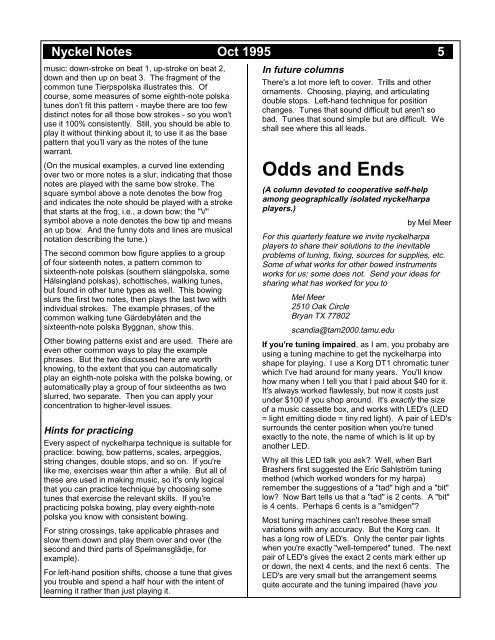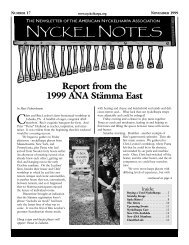Download Number 2 - American Nyckelharpa Association
Download Number 2 - American Nyckelharpa Association
Download Number 2 - American Nyckelharpa Association
You also want an ePaper? Increase the reach of your titles
YUMPU automatically turns print PDFs into web optimized ePapers that Google loves.
Nyckel Notes Oct 1995 5<br />
music: down-stroke on beat 1, up-stroke on beat 2,<br />
down and then up on beat 3. The fragment of the<br />
common tune Tierpspolska illustrates this. Of<br />
course, some measures of some eighth-note polska<br />
tunes don’t fit this pattern - maybe there are too few<br />
distinct notes for all those bow strokes - so you won’t<br />
use it 100% consistently. Still, you should be able to<br />
play it without thinking about it, to use it as the base<br />
pattern that you’ll vary as the notes of the tune<br />
warrant.<br />
(On the musical examples, a curved line extending<br />
over two or more notes is a slur, indicating that those<br />
notes are played with the same bow stroke. The<br />
square symbol above a note denotes the bow frog<br />
and indicates the note should be played with a stroke<br />
that starts at the frog, i.e., a down bow; the "V"<br />
symbol above a note denotes the bow tip and means<br />
an up bow. And the funny dots and lines are musical<br />
notation describing the tune.)<br />
The second common bow figure applies to a group<br />
of four sixteenth notes, a pattern common to<br />
sixteenth-note polskas (southern slängpolska, some<br />
Hälsingland polskas), schottisches, walking tunes,<br />
but found in other tune types as well. This bowing<br />
slurs the first two notes, then plays the last two with<br />
individual strokes. The example phrases, of the<br />
common walking tune Gärdebylåten and the<br />
sixteenth-note polska Byggnan, show this.<br />
Other bowing patterns exist and are used. There are<br />
even other common ways to play the example<br />
phrases. But the two discussed here are worth<br />
knowing, to the extent that you can automatically<br />
play an eighth-note polska with the polska bowing, or<br />
automatically play a group of four sixteenths as two<br />
slurred, two separate. Then you can apply your<br />
concentration to higher-level issues.<br />
Hints for practicing<br />
Every aspect of nyckelharpa technique is suitable for<br />
practice: bowing, bow patterns, scales, arpeggios,<br />
string changes, double stops, and so on. If you're<br />
like me, exercises wear thin after a while. But all of<br />
these are used in making music, so it's only logical<br />
that you can practice technique by choosing some<br />
tunes that exercise the relevant skills. If you're<br />
practicing polska bowing, play every eighth-note<br />
polska you know with consistent bowing.<br />
For string crossings, take applicable phrases and<br />
slow them down and play them over and over (the<br />
second and third parts of Spelmansglädje, for<br />
example).<br />
For left-hand position shifts, choose a tune that gives<br />
you trouble and spend a half hour with the intent of<br />
learning it rather than just playing it.<br />
In future columns<br />
There's a lot more left to cover. Trills and other<br />
ornaments. Choosing, playing, and articulating<br />
double stops. Left-hand technique for position<br />
changes. Tunes that sound difficult but aren't so<br />
bad. Tunes that sound simple but are difficult. We<br />
shall see where this all leads.<br />
Odds and Ends<br />
(A column devoted to cooperative self-help<br />
among geographically isolated nyckelharpa<br />
players.)<br />
by Mel Meer<br />
For this quarterly feature we invite nyckelharpa<br />
players to share their solutions to the inevitable<br />
problems of tuning, fixing, sources for supplies, etc.<br />
Some of what works for other bowed instruments<br />
works for us; some does not. Send your ideas for<br />
sharing what has worked for you to<br />
Mel Meer<br />
2510 Oak Circle<br />
Bryan TX 77802<br />
scandia@tam2000.tamu.edu<br />
If you’re tuning impaired, as I am, you probaby are<br />
using a tuning machine to get the nyckelharpa into<br />
shape for playing. I use a Korg DT1 chromatic tuner<br />
which I've had around for many years. You'll know<br />
how many when I tell you that I paid about $40 for it.<br />
It's always worked flawlessly, but now it costs just<br />
under $100 if you shop around. It's exactly the size<br />
of a music cassette box, and works with LED's (LED<br />
= light emitting diode = tiny red light). A pair of LED's<br />
surrounds the center position when you're tuned<br />
exactly to the note, the name of which is lit up by<br />
another LED.<br />
Why all this LED talk you ask? Well, when Bart<br />
Brashers first suggested the Eric Sahlström tuning<br />
method (which worked wonders for my harpa)<br />
remember the suggestions of a "tad" high and a "bit"<br />
low? Now Bart tells us that a "tad" is 2 cents. A "bit"<br />
is 4 cents. Perhaps 6 cents is a "smidgen"?<br />
Most tuning machines can't resolve these small<br />
variations with any accuracy. But the Korg can. It<br />
has a long row of LED's. Only the center pair lights<br />
when you're exactly "well-tempered" tuned. The next<br />
pair of LED's gives the exact 2 cents mark either up<br />
or down, the next 4 cents, and the next 6 cents. The<br />
LED's are very small but the arrangement seems<br />
quite accurate and the tuning impaired (have you
















